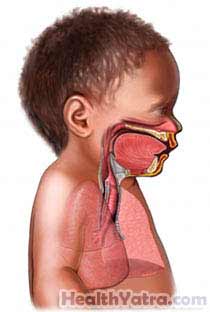تعريف
Respiratory distress syndrome (RDS) occurs most often in infants who are born too early. RDS can cause breathing difficulty in newborns. If it is not properly treated, RDS can result in complications. This may include pneumonia, respiratory failure, chronic lung problems, and possibly asthma. In severe cases, RDS can lead to convulsions and death.
أسباب
RDS occurs when infant’s lungs have not developed enough. Immature lungs lack a fluid called surfactant. This is a foamy liquid that helps the lungs open wide and take in air. When there is not enough surfactant, the lungs do not open well. This will make it difficult for the infant to breathe.
The chance of developing RDS decreases as the fetus grows. Babies born after 36 weeks rarely develop this condition.

عوامل الخطر
A risk factor is something that increases your chance of getting a disease or condition. Factors that increase your baby’s risk of RDS include:
- Birth before 37 weeks; increased risk and severity of condition with earlier prematurity
- Mother with insulin dependent diabetes
- Multiple birth
- Cesarean section delivery
- Cold stress
- Asphyxia
- Precipitous delivery
- Previously affected infant
- Being male
- Hypertension (high blood pressure) during pregnancy
الأعراض
The following symptoms usually start immediately or within a few hours after birth and include:
- Difficulty breathing, apnea
- Rapid, shallow breathing
- Delayed or weak cry
- Grunting noise with every breath
- Flaring of the nostrils
- Frothing at the lips
- Blue color around the lips
- Swelling of the extremities
- Decreased urine output
التشخيص
The doctor will ask about the mother’s medical history and pregnancy. The baby will also be evaluated, as outlined here:
Before Birth
Amniotic fluid is fluid that surrounds the fetus. It may be tested for indicators of well-developed lungs such as:
- Surfactant
- Lecithin:sphingomyelin ratio
- Phosphatidyl glycerol
After Birth
- Laboratory studies—done to rule out infection
- Physical exam—includes checking the baby’s breathing and looking for bluish color around the lips or on trunk
- Testing for blood gases—to check the levels of oxygen and carbon dioxide in the blood
- Chest x-ray —a test that uses radiation to take a picture of structures inside the body, in this case the heart and lungs
العلاج
Treatment for a baby with RDS usually includes oxygen therapy and may also include:
Mechanical Respirator
A mechanical respirator is a breathing machine. It is used to keep the lungs from collapsing and support the baby’s breathing. The respirator also improves the exchange of oxygen and other gases in the lungs. A respirator is almost always needed for infants with severe RDS.
Surfactant Treatment
Surfactant can be given to help the lungs open. Wider lungs will allow the infant to take in more oxygen and breathe normally. One type of surfactant comes from cows and the other is synthetic. Both options are delivered directly into the infant’s windpipe.
Inhaled Nitric Oxide
Nitric oxide is a gas that is inhaled. It can make it easier for oxygen to pass into the blood. The gas is often delivered during mechanical ventilation.
Nutrition Support
Newborns with RDS may be given food and water by the following means:
- Tube feeding —a tube is inserted through the baby’s mouth and into the stomach
- Parenteral feeding —nutrients are delivered directly into a vein
الوقاية
Preventing a premature birth is the best way to avoid RDS. To reduce your chance of having a premature baby:
- Get good prenatal care. Start as early as possible in pregnancy.
- Eat a healthful diet. Take vitamins as suggested by your doctor.
- Do not smoke. Avoid alcohol or drug use.
- Only take medicines that your doctor has approved.
If you are at high risk of giving birth to a premature baby:
- You may be given steroids about 24 hours before delivery. Steroids can help your baby’s lungs develop faster.
- Your doctor may do an amniocentesis. This test will check the maturity of your baby’s lungs. The results will help determine the best time for delivery.
Preventative treatments may be given to premature babies with a very high chance of developing RDS. These may include nasal continuous positive airway pressure (CPAP) or surfactant. The treatments are given soon after birth.
